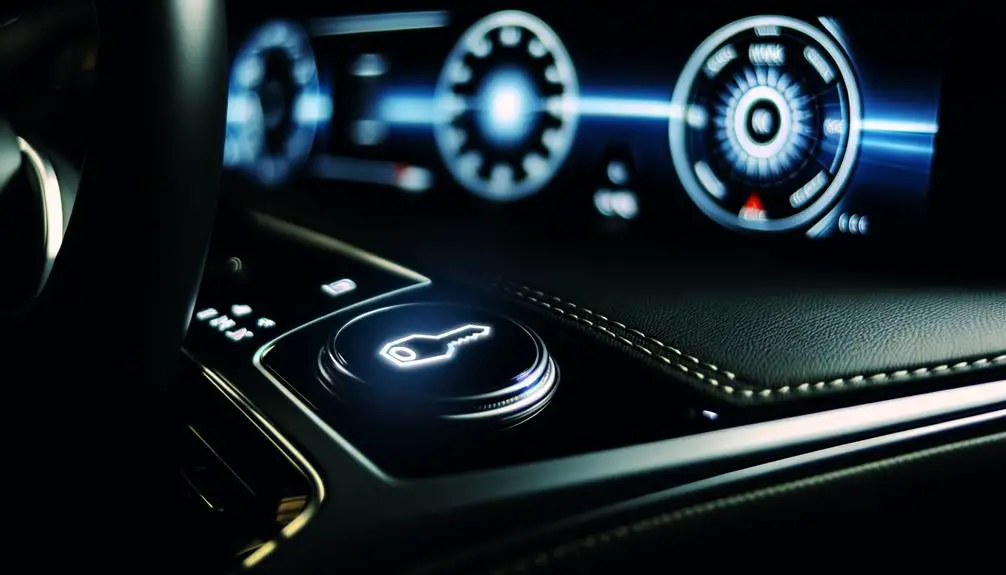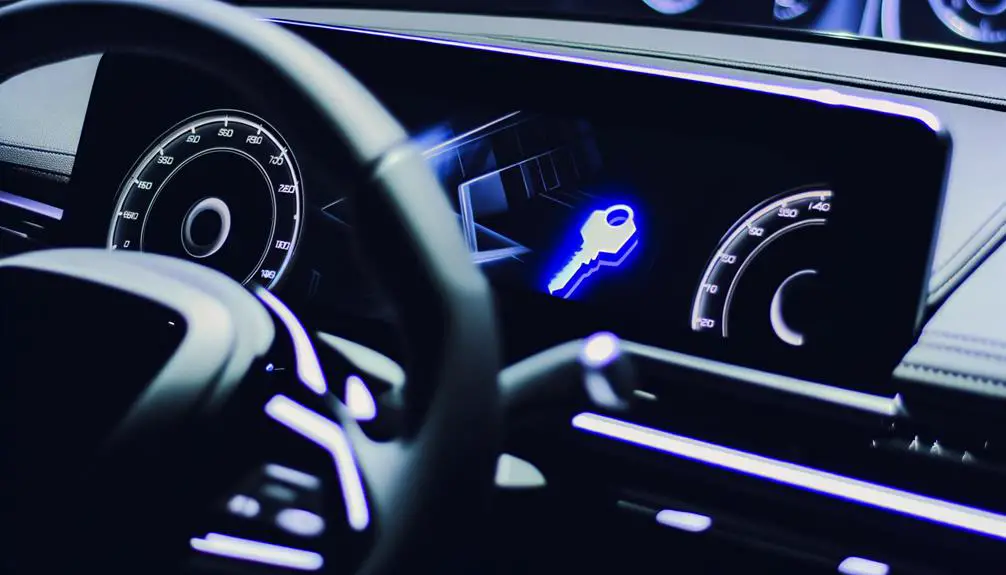What Does the Car Key Symbol Mean on the Dashboard?
A car dashboard displaying a key symbol typically signifies an issue with the vehicle's immobilizer system or keyless entry. This system prevents unauthorized engine start-up by ensuring proper communication between the key fob's transponder and the electronic control unit (ECU).
Common causes include key fob battery depletion, transponder chip damage, ECU communication faults, or external interference. Consequences range from ignition malfunctions to compromised security, necessitating immediate attention.
Understanding these potential issues is pivotal for effective diagnosis and maintaining vehicle functionality. By following relevant diagnostic steps and preventive measures, you can address these problems efficiently.
Discover more about essential troubleshooting techniques.

Key Takeaways
- The symbol indicates potential issues with the car's immobilizer system or keyless entry.
- Common causes include key fob battery depletion and transponder chip damage.
- It may signify communication faults between the key fob and the car's ECU.
- The symbol can point to ignition system malfunctions or security system errors.
- Immediate attention is required to maintain vehicle security and functionality.
Meaning of the Symbol

The main symbol displayed on a car's dashboard typically indicates an issue with the vehicle's immobilizer system or keyless entry mechanism. This icon is essential in modern vehicles, as it represents the technology responsible for preventing unauthorized engine start-up.
The immobilizer system uses a transponder within the key fob that communicates with the vehicle's electronic control unit (ECU). When functioning correctly, this interaction allows the engine to start. However, if the key symbol illuminates, it suggests a potential malfunction in this communication process.
Understanding the significance of this symbol can help drivers identify and address security-related issues promptly, ensuring best vehicle performance and safety. This indicator is vital for diagnosing problems that could compromise the vehicle's anti-theft measures.
Common Causes
Frequent illumination of the key symbol can often be attributed to a variety of underlying issues. These may include a malfunctioning key fob battery, damaged transponder chip, or faulty ECU communication. Understanding these common causes can help in diagnosing the problem more accurately.
Key factors include:
- Key Fob Battery: A depleted or weak battery in the key fob can prevent proper communication with the vehicle's immobilizer system.
- Transponder Chip: Damage or misalignment of the transponder chip within the key can disrupt signal transmission.
- ECU Communication: Faulty connections or software issues within the Engine Control Unit can lead to intermittent key recognition failures.
- Interference: External electronic interference can occasionally cause communication disruptions between the key fob and the vehicle.
Understanding these causes enables more effective troubleshooting.
Potential Issues

Potential issues signaled by the key symbol in your car can range from ignition system malfunctions to a depleted key fob battery, or even a security system error.
These problems can obstruct vehicle operation and require immediate attention to prevent further complications.
Understanding these issues is essential for maintaining vehicle security and ensuring seamless functionality.
Ignition System Malfunction
When a car displays a key symbol on the dashboard, it often indicates a malfunction within the ignition system that can stem from various underlying issues. These problems can disrupt the vehicle's ability to recognize the key, leading to ignition failures.
Key factors contributing to such malfunctions include:
- Faulty Ignition Switch: Worn contacts or internal damage can prevent the electrical circuit from closing properly.
- Transponder Key Issues: The chip within the key may fail to communicate correctly with the car's immobilizer system.
- Wiring Problems: Damaged or corroded wires can impede the signal transmission between the key and the ignition system.
- Electronic Control Unit (ECU) Failures: The ECU, responsible for managing ignition processes, might face software or hardware faults.
Understanding these potential issues is essential for diagnosing and addressing ignition system malfunctions effectively.
Key Fob Battery
A depleted or faulty key fob battery can disrupt the communication between the key fob and the car's receiver, leading to difficulties in accessing or starting the vehicle. This issue arises because the key fob relies on a continuous power source to transmit signals effectively.
Typically, symptoms manifest as intermittent locking or opening problems, or a complete failure to start the car using the push-button ignition. Industry insights suggest regularly replacing the battery, ideally every 1-2 years, to maintain peak functionality. Using high-quality batteries is advisable to guarantee longevity.
Additionally, some advanced key fobs may display a low battery warning, allowing for timely replacements before the key fob malfunctions entirely.
Security System Error
Security system errors in modern vehicles can stem from various issues, ranging from software glitches to hardware malfunctions. These errors often manifest as a key symbol on the dashboard, signaling that the vehicle's anti-theft system is compromised. Understanding the root cause is essential for effective troubleshooting.
Potential issues include:
- Key fob malfunction: A defective or deprogrammed key fob can prevent the vehicle from recognizing the key.
- Immobilizer system failure: Problems with the immobilizer can inhibit engine start.
- Wiring issues: Damaged or corroded wiring can disrupt communication between the key fob and the vehicle.
- Software bugs: Firmware updates or software errors can lead to false security alerts.
Accurate diagnostics and professional intervention are often required to resolve these issues efficiently.
Diagnostic Steps
To accurately diagnose the significance of a key symbol appearing on your car's dashboard, initiate a thorough system scan using an OBD-II diagnostic tool. This essential device interfaces with your vehicle's onboard computer to retrieve fault codes, providing a clear indication of any underlying issues.
Begin by ensuring the tool is compatible with your car model, then connect it to the OBD-II port, typically located under the dashboard. Follow the device's instructions to perform an in-depth scan.
Analyze the diagnostic trouble codes (DTCs) displayed, focusing on those related to the vehicle's immobilizer system or key fob transmitter. Cross-reference these codes with your car's service manual for accurate interpretation, ensuring a precise understanding of the root cause.
Preventive Measures

Effective preventive measures are essential for securing the longevity and reliability of your vehicle's immobilizer system and key fob functions. Regular maintenance can help prevent potential issues and extend the lifespan of these critical components.
Here are some key actions to keep in mind:
- Battery Replacement: Periodically check and change the key fob battery to maintain uninterrupted communication with the immobilizer.
- Signal Interference: Avoid exposing the key fob to electromagnetic fields or keeping it near devices that could disrupt its signal.
- Physical Protection: Shield the key fob from physical damage by using a protective cover.
- Software Updates: Ensure your vehicle's software is up to date to take advantage of the latest security enhancements and bug fixes.
When to Seek Help
While preventive measures can greatly reduce the risk of immobilizer and key fob issues, there are certain scenarios where professional assistance becomes imperative.
If your vehicle consistently fails to recognize the key fob, even after battery replacement, or if the 'key' symbol persists on the dashboard, it indicates a deeper electronic malfunction.
Additionally, if the immobilizer system fails to disengage, rendering the car inoperable, expert diagnosis is required.
Complexities in modern vehicle security systems often necessitate specialized tools and advanced knowledge that only certified technicians possess. Ignoring these signs can lead to more severe, costly repairs.
Seeking professional help ensures that the issue is accurately identified and resolved, safeguarding both vehicle functionality and driver safety.
Conclusion
Understanding the key symbol in a car is vital for maintaining vehicle functionality and safety.
Delving into the meaning of the symbol, identifying common causes, recognizing potential issues, following diagnostic steps, and implementing preventive measures can mitigate risks.
Engaging in these practices guarantees peak performance and prolongs vehicle lifespan.
When issues persist despite these efforts, seeking professional assistance becomes essential.
This structured approach fosters automotive reliability, enhances driver confidence, and safeguards against unexpected malfunctions.





